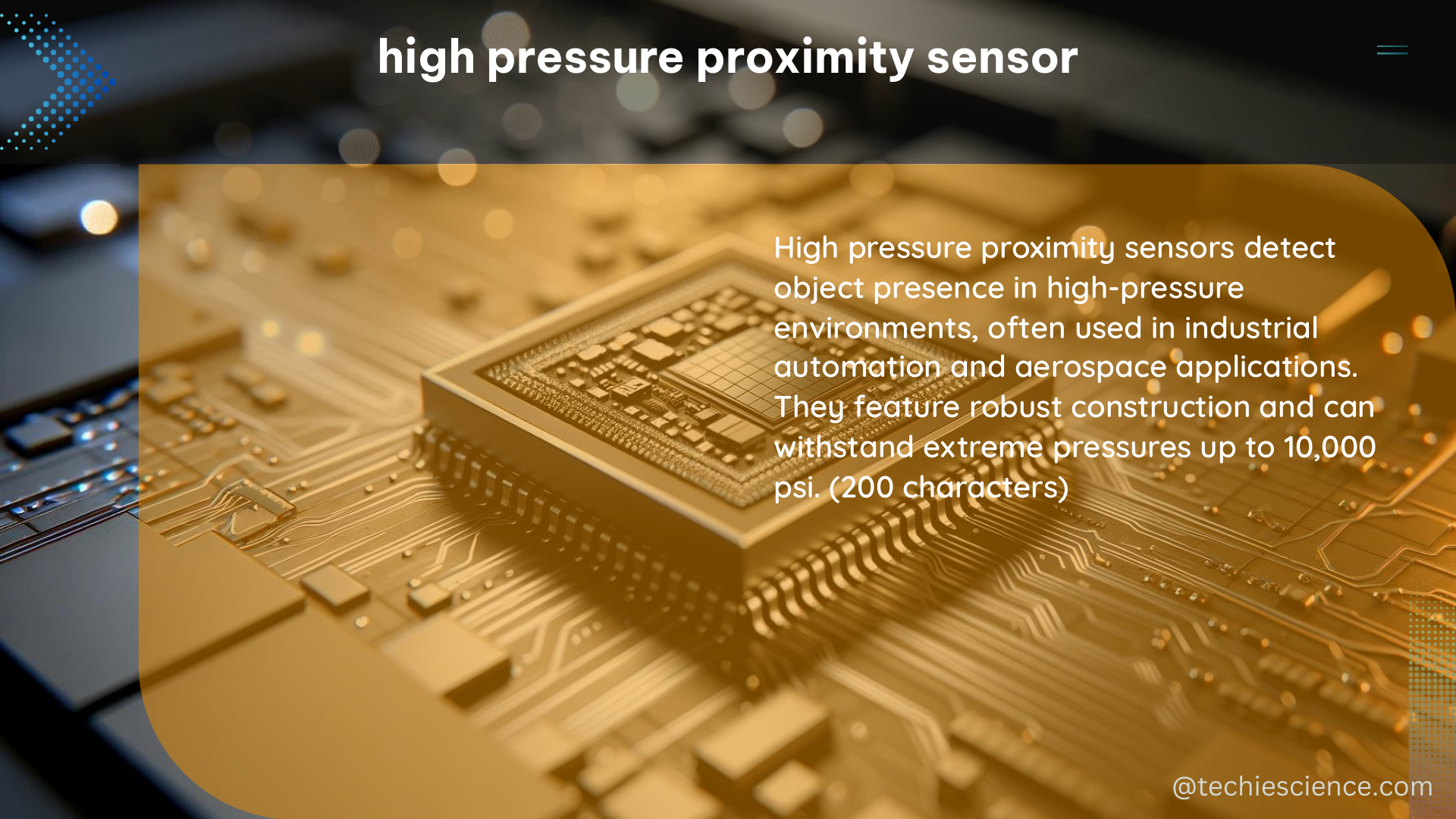High pressure proximity sensors are specialized devices used to detect the presence, position, or movement of objects in a wide range of industrial and commercial applications. These sensors are designed to operate reliably in harsh environments, withstanding high pressures, temperatures, and other challenging conditions. Whether you’re a DIY enthusiast, an engineer, or a technician, understanding the intricacies of high pressure proximity sensors is crucial for ensuring accurate and reliable measurements.
Technical Specifications of High Pressure Proximity Sensors
High pressure proximity sensors are engineered to withstand extreme conditions, with the ability to operate in pressures up to 10,000 psi (689 bar) and temperatures ranging from -40°C to 200°C. These sensors typically have a precision measuring range of 30-50% of the sensor coil diameter, allowing for accurate detection of targets at distances up to 2 times the diameter of the sensor.
| Specification | Range |
|---|---|
| Pressure Rating | Up to 10,000 psi (689 bar) |
| Temperature Range | -40°C to 200°C |
| Measuring Range | 30-50% of sensor coil diameter |
| Detection Distance | Up to 2 times the sensor diameter |
| Shock Resistance | Up to 100 G |
| Vibration Resistance | Up to 10 G |
It’s important to note that the sensor’s performance can be affected by various environmental factors, such as temperature, pressure, vibration, and electromagnetic interference (EMI). Careful consideration of these factors is crucial when selecting and installing high pressure proximity sensors.
Sensor Types and Applications

High pressure proximity sensors come in a variety of types, each with its own unique characteristics and applications. Some of the most common types include:
-
Inductive Proximity Sensors: These sensors use an electromagnetic field to detect the presence of metallic objects. They are widely used in industrial automation, machinery, and robotics applications.
-
Capacitive Proximity Sensors: These sensors detect the presence of both metallic and non-metallic objects by measuring changes in the electrical field. They are often used in applications involving liquids, powders, and non-conductive materials.
-
Ultrasonic Proximity Sensors: These sensors use high-frequency sound waves to detect the presence and distance of objects, regardless of their material composition. They are commonly used in level measurement, object detection, and distance sensing applications.
-
Photoelectric Proximity Sensors: These sensors use light-based technology to detect the presence of objects. They are suitable for a wide range of applications, including object detection, counting, and positioning.
High pressure proximity sensors find applications in various industries, including:
- Oil and gas exploration and production
- Aerospace and defense
- Automotive manufacturing
- Hydraulic and pneumatic systems
- Chemical processing
- Power generation
- Subsea and offshore operations
Sensor Compatibility and Integration
When using high pressure proximity sensors in DIY projects or industrial applications, it’s crucial to ensure compatibility with the measurement device or control system. For example, an inductive proximity sensor with a PNP NO output can be connected to a cDAQ-9188 and a NI-9215 module, but the sensor’s output type and range must be considered to ensure proper integration.
To ensure accurate and reliable measurements, it’s important to consider factors such as the sensor’s measuring range, offset, and mounting. Unstable or non-repeatable fixturing can lead to non-repeatable results, and “side loading” can affect sensor performance if not originally calibrated for.
Sensor Calibration and Maintenance
Proper calibration and maintenance of high pressure proximity sensors are essential for ensuring accurate and consistent measurements. Calibration should be performed regularly, taking into account factors such as temperature, pressure, and the specific application requirements.
During the calibration process, the sensor’s offset, sensitivity, and linearity should be verified and adjusted as necessary. It’s also important to inspect the sensor for any physical damage or wear and tear, and to clean the sensor’s surface to maintain optimal performance.
Conclusion
High pressure proximity sensors are versatile and essential tools in a wide range of industrial and commercial applications. By understanding the technical specifications, sensor types, compatibility, and maintenance requirements, you can ensure accurate and reliable measurements in even the most challenging environments. Whether you’re a DIY enthusiast or a professional engineer, this comprehensive guide will help you navigate the world of high pressure proximity sensors with confidence.
References:
- Jörg Müller, Julio Meneses, Anne Laure Humbert, and Elisabeth Anna Guenther, “Sensor-based proximity metrics for team research. A validation study across three organizational contexts,” Sensor-based proximity metrics for team research. A validation study across three organizational contexts, 2020.
- “Sensor System – an overview | ScienceDirect Topics,” ScienceDirect, 2022.
- “Inductive proximity sensor reading – NI Community,” NI Community, 2013.
- “INDUCTIVE TECHNOLOGY HANDBOOK,” Kaman Sensors, 2012.
- “High Pressure Proximity Sensors: Specifications and Applications,” Omega Engineering, 2022.
- “Understanding Proximity Sensors: Types, Applications, and Considerations,” Automation.com, 2019.
- “Calibration and Maintenance of Proximity Sensors,” Pepperl+Fuchs, 2020.

The lambdageeks.com Core SME Team is a group of experienced subject matter experts from diverse scientific and technical fields including Physics, Chemistry, Technology,Electronics & Electrical Engineering, Automotive, Mechanical Engineering. Our team collaborates to create high-quality, well-researched articles on a wide range of science and technology topics for the lambdageeks.com website.
All Our Senior SME are having more than 7 Years of experience in the respective fields . They are either Working Industry Professionals or assocaited With different Universities. Refer Our Authors Page to get to know About our Core SMEs.